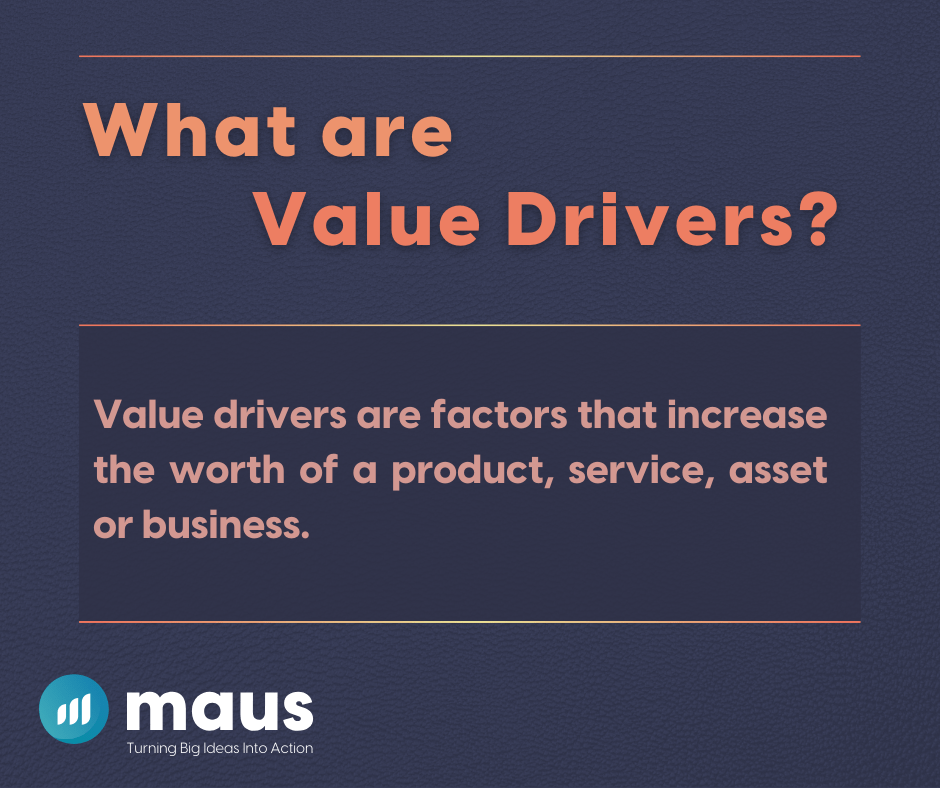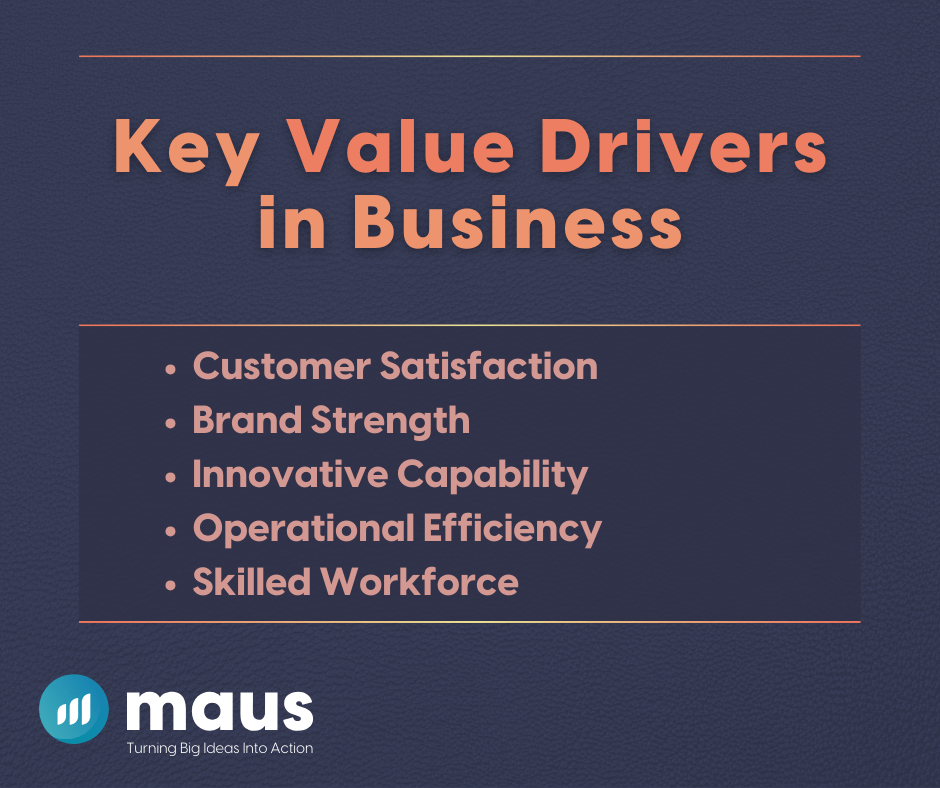In the business world, understanding and leveraging value drivers is crucial for enhancing business valuation, ensuring sustainable growth, and preparing for potential risks or exit strategies. But what exactly are value drivers, and how do they impact a company’s performance and valuation?
This article defines value drivers in business, their role in value-driven enterprise risk management, and how companies can identify and cultivate them to maximize business success.
What are Value Drivers?

Value drivers are elements or factors that significantly contribute to the value of a business. They influence a company’s financial performance, ability to generate revenue, maintain profitability, and secure a competitive advantage in the market.
Gartner defines them as:
Value drivers are factors that increase the worth of a product, service, asset or business. In the case of a product, it could be a differentiating capability that makes the product a must-have for customers. For a business, it could be economies of scale, skilled staff or a loyal customer base that increases the value of the business for shareholders and potential buyers.
These drivers vary across different industries and businesses but typically include aspects such as a strong brand reputation, a loyal customer base, innovative products or services, efficient operations, and a skilled workforce.
Key Value Drivers in Business
Understanding the key value drivers for your business is essential for strategic planning and your business growth strategy. These drivers, integral to your business valuation, range from fostering high customer satisfaction to maintaining a skilled workforce. Let’s delve deeper into how each of these value drivers plays a crucial role in the prosperity and valuation of a business.
Some of the most common value drivers include:
Customer Satisfaction
High levels of customer satisfaction are not just desirable; they are essential for the vitality of your business. Satisfied customers are the most reliable source of recurring revenue, as their repeat business and referrals contribute significantly to stable cash flows.
Cultivating a high customer satisfaction rate involves understanding and meeting customer needs consistently, ensuring quality control in your products or services, and delivering exceptional customer service. In today’s digital world, positive online reviews and word-of-mouth recommendations can significantly boost your brand’s visibility and attractiveness to potential customers.
Brand Strength
A strong, recognizable brand goes beyond a logo or slogan; it represents a promise of quality and reliability to your customers. Brand strength is a powerful value driver that can command premium pricing and foster customer loyalty, setting your business apart in crowded marketplaces.
Developing a strong brand requires a coherent brand strategy that aligns with your customers’ values and expectations, consistently delivered across all touchpoints. A robust brand not only attracts high customer loyalty but also enhances your business valuation by representing a reliable asset for future earnings.
Innovative Capability
The ability to innovate and adapt to changes is crucial for staying ahead of competitors. Innovative capability is a key value driver that enables businesses to explore new markets, develop new products or services, and improve existing offerings.
This agility can significantly enhance your growth strategy by opening up new revenue streams and ensuring your business remains relevant and competitive.
Investing in research and development, fostering a culture of innovation, and encouraging creativity among your human resources are vital steps toward harnessing this value driver.
Operational Efficiency
Efficient operations are the backbone of a business’s financial performance. Streamlining processes, reducing waste, and optimizing resource allocation contribute to lower operational costs and improved profit margins.
Operational efficiency directly impacts the bottom line, making it a critical value driver for any business. This can involve adopting new technologies, improving supply chain management, and training staff to enhance productivity. By focusing on operational efficiency, businesses can generate more value from their existing resources, bolstering cash flows and enhancing business valuation.
Skilled Workforce
A talented and motivated workforce is indispensable for driving innovation, efficiency, and service quality. Human resources are a critical asset that can propel your growth strategy, helping your business adapt to market changes, improve operational efficiency, and maintain high customer satisfaction.
Investing in employee development, fostering a positive workplace culture, and recruiting top talent are key strategies for maximizing this value driver. A skilled workforce not only contributes to immediate operational success but also supports long-term business valuation by ensuring the company’s ability to innovate and grow.

Value Drivers of a Company: The Role in Enterprise Risk Management
In the context of enterprise risk management (ERM), value drivers are considered both assets to be protected and sources of potential risk. A value-driven ERM approach focuses on identifying, assessing, and managing risks that could negatively impact the company’s key value drivers.
By aligning risk management strategies with value drivers, companies can ensure that protective measures contribute directly to sustaining and enhancing business value.
Identifying Your Company’s Value Drivers
To identify your company’s value drivers, consider factors that directly influence customer decisions, operational effectiveness, and competitive positioning. This process often involves analyzing financial data, customer feedback, and market trends.
Engaging with stakeholders, including employees, customers, and suppliers, can also provide valuable insights into what makes your business unique and valuable.
Leveraging Value Drivers for Growth
Once identified, companies should focus on nurturing and protecting these value drivers. This can involve investing in employee training, enhancing product quality, implementing efficient processes, or strengthening customer relationships.
Regularly monitoring and adjusting strategies in response to changes in the business environment is also crucial to maintaining the relevance and impact of these value drivers.
Conclusion
Value drivers are at the heart of a company’s success, influencing its ability to generate revenue, achieve growth, and navigate risks. By understanding, identifying, and leveraging these critical factors, businesses can enhance their value and secure a competitive edge in the marketplace. Whether through value-driven enterprise risk management or strategic planning, focusing on value drivers is essential for any company aiming for long-term success and sustainability.
Incorporating value drivers into your business strategy not only prepares your company for growth but also for potential exits or transitions, much like the role of a Certified Exit Planning Advisor (CEPA) in preparing businesses for ownership transitions.
Just as CEPAs focus on maximizing business value and ensuring a smooth transition, understanding and optimizing your business’s value drivers can significantly impact its future success and legacy.



